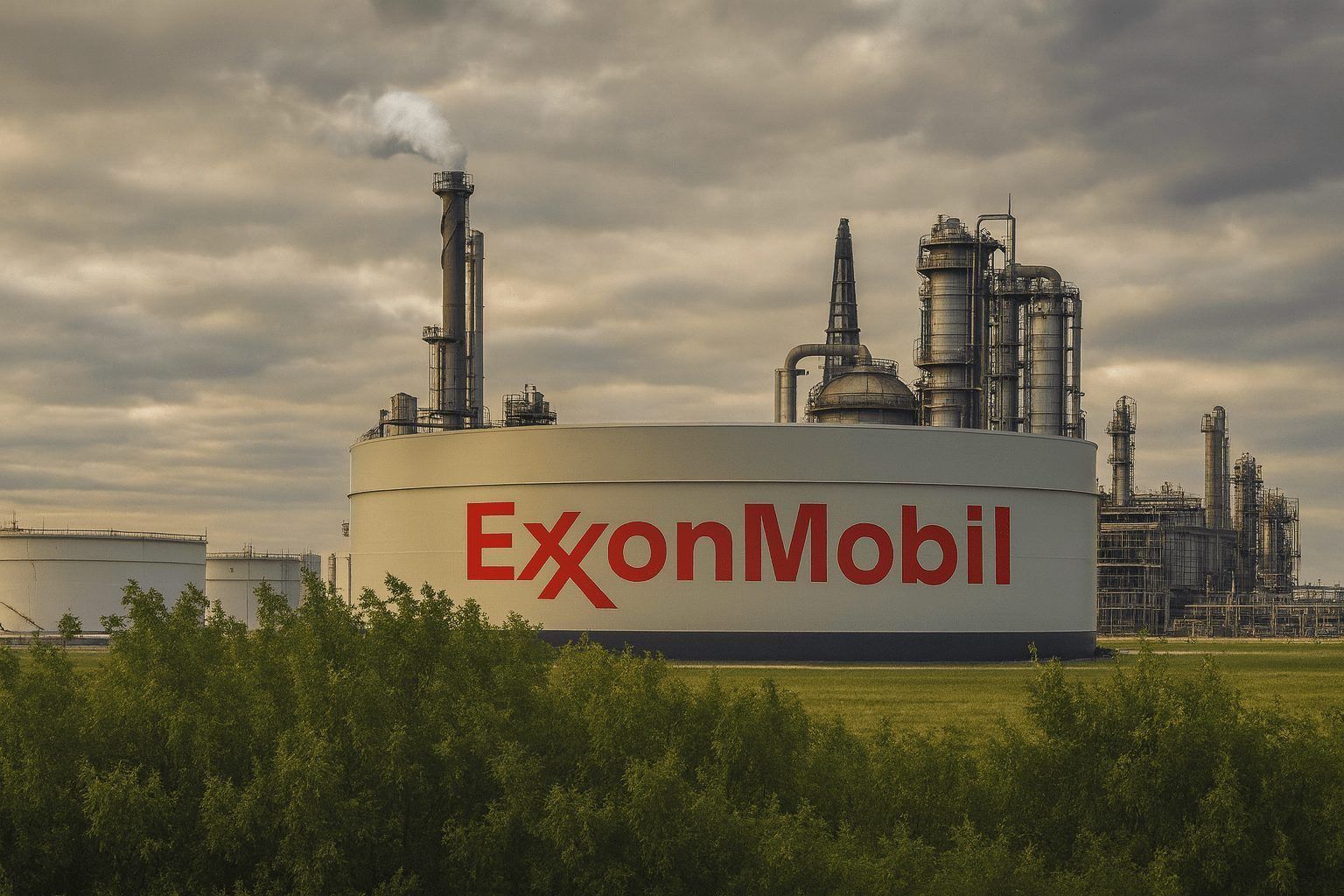Updated: November 22, 2025
Exxon Mobil Corporation (NYSE: XOM) is heading into the weekend trading just above $117 per share, after closing Friday’s session at $117.08 on volume of about 15.7 million shares. [1]
That leaves ExxonMobil’s share price less than 5% below its 52‑week high of $123.21 and roughly mid-range between that high and its 12‑month low around $97.80. [2] At the current level, the oil major carries a market capitalization of about $494 billion and trades at around 17 times trailing earnings, with a forward dividend yield near 3.5%. [3]
While crude prices have slipped to one‑month lows, ExxonMobil continues to post robust cash flows, raise its dividend and advance major growth projects in Guyana and the Permian Basin—against the backdrop of a more cautious stance on some low‑carbon investments.
ExxonMobil stock today: price and valuation snapshot
As of the close on Friday, November 21, 2025, ExxonMobil stock: [4]
- Last close: $117.08
- Intraday range: $115.65 – $117.38
- 1‑year range: $97.80 – $123.21
- Market cap: ≈ $493.75 billion
- Trailing P/E: ~16.6
- Forward P/E: ~16.0
- Dividend yield (forward): ~3.5% based on a $4.12 annual dividend
According to MarketBeat and other data providers, Exxon’s 50‑day simple moving average is around $114.69, with the 200‑day average near $111.04, suggesting the stock is trading modestly above both medium‑ and long‑term trend lines. [5]
On a performance basis, XOM is up about 9% year‑to‑date on price alone, and roughly 13% including reinvested dividends, underscoring the contribution of income to total return. [6]
Balance‑sheet quality remains a key part of the story. ExxonMobil’s debt‑to‑capital ratio sits around 13.5%, with net‑debt‑to‑capital just 9.5% and a cash balance of about $13.9 billion, giving the company plenty of flexibility to keep investing and returning cash even in a softer commodity environment. [7]
Macro backdrop: oil prices slide to one‑month lows
ExxonMobil’s share price can’t be separated from what’s happening in the oil market.
On Friday, Brent crude settled at $62.56 per barrel and WTI at $58.06, both down about 1% on the day and roughly 3% for the week—their lowest closes since late October. [8]
According to Reuters, the decline has been driven by: [9]
- Concerns that a potential Russia–Ukraine peace framework could eventually boost global crude supply
- A stronger U.S. dollar, which makes dollar‑denominated oil more expensive for many buyers
- Ongoing unease about global growth and interest‑rate policy
For integrated oil majors like ExxonMobil, lower oil prices compress upstream margins but are partially offset by downstream and chemicals, especially when refining margins hold up. Still, a sustained move in Brent near the low‑$60s is a clear headwind to earnings compared with the $70–80 range many producers enjoyed recently.
Q3 2025: earnings beat, record production in Guyana and the Permian
ExxonMobil’s latest reported quarter—Q3 2025—helps to explain why the stock has held up despite softer crude.
In its October 31 earnings release, the company reported: [10]
- Earnings: $7.5 billion
- GAAP EPS: $1.76
- EPS excluding items: $1.88 (beating the Zacks consensus of $1.81)
- Operating cash flow: $14.8 billion
- Free cash flow: $6.3 billion
- Shareholder distributions: $9.4 billion in the quarter
- ≈ $4.2 billion in dividends
- ≈ $5.1 billion in share repurchases
Year‑to‑date through Q3, Exxon generated $39.3 billion in cash flow from operations and $20.6 billion in free cash flow, returning $27.8 billion to shareholders via dividends and buybacks. [11]
Management emphasized that Q3 delivered the highest earnings per share the company has seen in a comparable oil‑price environment, crediting: [12]
- Advantaged volumes in Guyana and the Permian Basin
- More than $14 billion in structural cost savings achieved since 2019
- Strong operating performance in refining and chemicals, despite bottom‑of‑cycle petrochemical margins
Overall, year‑to‑date earnings of $22.3 billion are still below last year’s $26.1 billion, mainly due to lower crude prices, weaker chemical margins and higher depreciation. But volume growth and cost cuts are cushioning the blow.
Growth engines: Guyana and the Permian drive low‑cost barrels
Two regions underpin ExxonMobil’s growth narrative: offshore Guyana and the Permian Basin.
Guyana: 900,000 barrels a day and counting
On November 12, ExxonMobil announced that daily production in the Stabroek block offshore Guyana hit 900,000 barrels of oil per day, helped by the ramp‑up of the Yellowtail project to full capacity. [13]
Key Guyana milestones and targets:
- Yellowtail, Guyana’s fourth offshore project, is now producing at its planned 250,000 barrels per day capacity.
- Combined with Liza Phase 1, Liza Phase 2 and Payara, that pushed the block to the 900,000 bpd milestone.
- ExxonMobil and its partners have committed over $60 billion to seven sanctioned projects, with production capacity expected to reach 1.7 million bpd from eight developments by 2030. [14]
- ExxonMobil Guyana is the operator with 45% interest, alongside Hess (30%) and CNOOC (25%). [15]
In the Q3 release, Exxon also highlighted that quarterly production in Guyana surpassed 700,000 oil‑equivalent barrels per day, underlining how quickly Guyana has become central to the company’s upstream mix. [16]
Because Guyana’s developments sit in the low end of the global cost curve, they’re designed to generate returns even if Brent prices stay in the $50–60 range—an important cushion if the current oversupply fears prove accurate.
Permian Basin: record volumes and more midstream capacity coming
The Permian Basin remains Exxon’s second major growth pillar. In Q3, the company set another production record there, with nearly 1.7 million oil‑equivalent barrels per day of output. [17]
To support rising liquids production, Exxon is also pushing deeper into midstream. This week, Reuters reported that Exxon will acquire a 40% stake in Enterprise Products Partners’ Bahia natural gas liquids (NGL) pipeline, reimbursing roughly $650 million of project costs to date. [18]
Key details from the Bahia deal: [19]
- The 550‑mile line will initially move 600,000 bpd of mixed NGLs from the Midland and Delaware basins to Enterprise’s Mont Belvieu hub in Texas.
- Capacity is planned to rise to 1 million bpd by 2027 via additional pumping stations and a 92‑mile extension to Exxon’s Cowboy gas processing plant in New Mexico.
- The extension—dubbed the “Cowboy Connector”—will be operated by Enterprise but materially enhances Exxon’s ability to move NGL volumes out of the Permian.
Taken together with Guyana, the Permian gives Exxon a growing portfolio of “advantaged barrels”—high‑margin production that can remain profitable even in a more challenging oil‑price environment.
Strategic rethink: hydrogen project paused amid weak demand
Not all of ExxonMobil’s capital plans are moving full steam ahead.
On November 21, Reuters reported that Exxon has paused plans to build what would have been one of the world’s largest hydrogen production facilities at its Baytown, Texas complex. [20]
The Baytown project was designed to: [21]
- Produce up to 1 billion cubic feet per day of “blue” hydrogen from natural gas
- Capture and store the resulting CO₂ underground as part of a large‑scale carbon capture hub
CEO Darren Woods told Reuters that weak customer demand and a lack of long‑term offtake contracts are the primary reasons for the pause, despite about $500 million in spending already committed. Exxon says it still believes the project will eventually be needed, but will only move forward when customers are ready to pay the premium for low‑carbon hydrogen.
For investors, the takeaway is nuanced:
- The pause underscores Exxon’s capital discipline and focus on near‑term returns.
- But it also highlights the commercial challenges of decarbonization projects, and could raise questions about the pace of Exxon’s low‑carbon growth relative to peers.
Dividend, buybacks and balance sheet: why income investors watch XOM
ExxonMobil remains one of the market’s flagship income stocks.
In conjunction with Q3 results, the board raised the quarterly dividend by 4% to $1.03 per share, payable December 10, 2025 to shareholders of record on November 14. [22]
At the current share price, that implies: [23]
- Annualized dividend: $4.12 per share
- Forward dividend yield: ~3.5%
- Dividend growth streak: more than four decades of consecutive annual increases
- Payout ratio: ~58% of earnings
In Q3 alone, Exxon returned $9.4 billion to shareholders—$4.2 billion via dividends and $5.1 billion via share repurchases—and remains on track to repurchase about $20 billion of stock for the full year. [24]
Crucially, those cash returns are backed by a fortress‑like balance sheet:
- Net‑debt‑to‑capital around 9.5%
- Cash and equivalents near $13.9 billion
- Management on track to exceed $18 billion in structural cost savings by 2030, from a base of $14+ billion already achieved. [25]
For income‑focused investors, that combination of yield, dividend growth and balance‑sheet strength is a major part of the bullish case.
Analyst sentiment: “Moderate Buy” with high‑single‑digit upside
Wall Street still leans positive on ExxonMobil stock, though not unanimously.
According to MarketBeat’s latest summary of 20 brokerages: [26]
- Consensus rating: Moderate Buy
- Breakdown: 2 Strong Buy, 8 Buy, 10 Hold; no Sell ratings in the latest tally
- Average 12‑month price target: ≈ $128.7
- Implied upside: roughly 9–10% from Friday’s close
Other aggregators paint a similar picture:
- StockAnalysis reports a “Buy” consensus and an average target around $128.7, implying nearly 10% upside. [27]
- TipRanks cites an average target near $131, with a Moderate Buy consensus based on 11 Buys and 4 Holds—about 11–12% upside. [28]
- MarketWatch lists an average target of ~$127.6 and an overall “Overweight” recommendation from 30 analysts. [29]
Meanwhile, the latest MarketBeat note shows the stock opening Friday exactly at $117.08, with a P/E near 16.6, beta around 0.49, and institutional ownership of roughly 62%—marks consistent with a mega‑cap “defensive cyclical” rather than a high‑beta energy trade. [30]
Institutional flows: mixed but generally supportive
Recent 13F filings show a dynamic but broadly constructive institutional picture: [31]
- Rhumbline Advisers trimmed its XOM stake by about 3% in Q2, selling just over 227,000 shares but still holding more than 7.4 million shares worth nearly $800 million, making Exxon its 17th‑largest position.
- Other institutions—including MUFG Securities Americas and Bahl & Gaynor Inc.—have recently increased their ExxonMobil holdings, according to MarketBeat‑summarized filings.
The net message: some profit‑taking at the margin, but sustained interest from large funds that view XOM as a core holding.
Key risks investors are watching
Even with strong operations and a solid balance sheet, ExxonMobil is not risk‑free. Key issues on investor radar include:
- Oil‑price volatility and demand uncertainty
- With Brent near $62.56 and WTI around $58.06, any prolonged oversupply—perhaps from a Russia–Ukraine peace deal or slower global demand—could pressure upstream earnings further. [32]
- Energy transition and regulatory risk
- The pause of the Baytown hydrogen project highlights the difficulty of earning acceptable returns in some low‑carbon segments today, but also exposes Exxon to scrutiny from investors who want faster progress on decarbonization. [33]
- Project execution and geopolitical risk in Guyana
- Guyana has transformed Exxon’s growth profile, but it’s a single emerging‑market jurisdiction with political, social and environmental sensitivities. Any changes in fiscal terms, regulatory approvals, or local opposition could affect long‑term returns. [34]
- Refining and chemicals cycle
- While cost efficiencies and record throughput have supported earnings, the company itself notes that chemical margins remain at or near the bottom of the cycle, leaving room for further downside if demand weakens. [35]
- Broader equity‑market valuation risk
- U.S. markets have been volatile, with growing concern about whether current valuations are sustainable if economic growth slows. Even high‑quality cash‑generating names like Exxon can sell off during broader risk‑off episodes. [36]
Bottom line: how ExxonMobil stock is positioned going into year‑end
At roughly $117 per share, ExxonMobil stock (XOM) offers investors:
- Exposure to large‑scale, low‑cost oil and gas growth in Guyana and the Permian
- A forward dividend yield around 3.5%, supported by a multi‑decade record of dividend growth and a conservative payout ratio
- Substantial share buybacks and a strong balance sheet that together underpin shareholder returns
- An analyst consensus centered around a Moderate Buy rating with high‑single‑digit to low‑double‑digit expected upside over the next 12 months
Against that, investors need to weigh:
- Soft oil prices near recent lows
- Uncertainties around the pace and profitability of the energy transition
- Geopolitical and execution risks tied to major projects
For long‑term investors comfortable with commodity cycles, ExxonMobil remains widely viewed as a defensive way to own the energy sector—less volatile than many pure‑play producers, but still sensitive to macro and policy shifts.
Important: This article is for information and news purposes only and does not constitute investment advice or a recommendation to buy or sell any security. Always conduct your own research and consider speaking with a qualified financial adviser before making investment decisions.
References
1. finance.yahoo.com, 2. www.marketbeat.com, 3. stockanalysis.com, 4. finance.yahoo.com, 5. www.marketbeat.com, 6. www.marketbeat.com, 7. investor.exxonmobil.com, 8. www.reuters.com, 9. www.reuters.com, 10. investor.exxonmobil.com, 11. investor.exxonmobil.com, 12. investor.exxonmobil.com, 13. corporate.exxonmobil.com, 14. corporate.exxonmobil.com, 15. corporate.exxonmobil.com, 16. investor.exxonmobil.com, 17. investor.exxonmobil.com, 18. www.reuters.com, 19. www.reuters.com, 20. www.reuters.com, 21. www.reuters.com, 22. investor.exxonmobil.com, 23. stockanalysis.com, 24. investor.exxonmobil.com, 25. investor.exxonmobil.com, 26. www.marketbeat.com, 27. stockanalysis.com, 28. www.tipranks.com, 29. www.marketwatch.com, 30. www.marketbeat.com, 31. www.marketbeat.com, 32. www.reuters.com, 33. www.reuters.com, 34. corporate.exxonmobil.com, 35. corporate.exxonmobil.com, 36. markets.financialcontent.com







